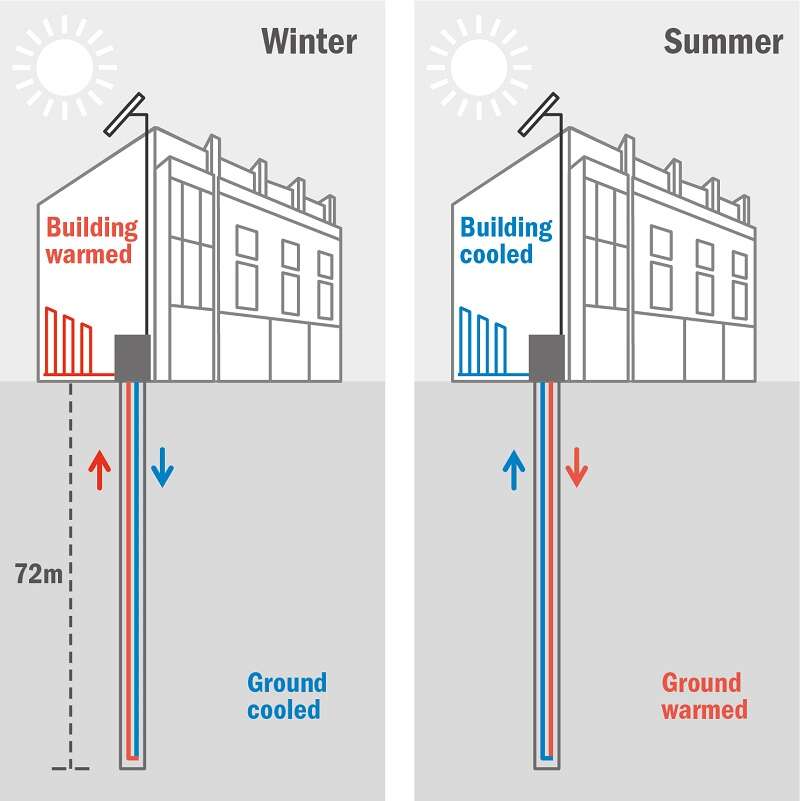Incorporating a ground source heat pump into a large building is becoming an increasingly popular option, and it’s easy to see why. Ground source heat pumps are sustainable, provide a comfortable, reliable heat and ensure low operating costs.
Ground Source Heat Pump Basics

Ground source heat pump systems are highly efficient because they move heat from place to place, instead of generating it from a fuel source like oil, natural gas or electricity.
A commercial geothermal heat pump operates on a simple principle: it moves heat from one place to another via a refrigeration process. In a commercial building, a series of heat pumps removes heat from an energy supply source in the ground. The heat pump concentrates this low-grade heat, raising its temperature and then transfers it to the building’s energy distribution system via a heat exchanger.
In the summer, the process is reversed. The heat pumps collect heat from the building and deposit it into the ground loop, providing cooling.
Since the ground maintains a constant temperature of 55-70°F depending on location, a geothermal HVAC system can save 25-50 percent on HVAC costs compared to conventional systems using air source condensing units for cooling and fossil fuels for heating.
Types of Ground Source Heat Pump Systems
There are three basic types of loop systems and their uses depends on the climate, soil conditions, available land, and other site-specific considerations.
- Closed-Loop Systems
Closed-loop systems are those in which heat-transfer fluid continuously circulates in a closed loop that’s filled just once and used again; no fluid can escape, and no outside materials can enter. Because of this, most closed-loop geothermal heat pumps circulate an antifreeze solution through a closed loop — usually made of plastic tubing — that is buried in the ground or submerged in water. A heat exchanger transfers heat between the refrigerant in the heat pump and the antifreeze solution in the closed loop.
Closed loop geothermal ground loops can last 50+ years with little to no maintenance. Once installed, the buried ground loop will be a permanent fixture on the property for as long as there is a building to heat and cool.
For commercial and industrial applications, the loop can be in two types of configurations:
- Vertical GSHP Configuration
Large commercial buildings and schools often use vertical systems because the land area required for horizontal loops would be prohibitive. Vertical loops are also used where the soil is too shallow for trenching, and they minimize the disturbance to existing landscaping. Vertical loops are connected with horizontal pipe, placed in trenches, and connected to the heat pump in the building.
- Pond/Lake GSHP Configuration
A pond / lake ground loop is a series of plastic pipes filled with heat-transfer fluid and submerged in a nearby pond or lake with adequate size, depth, and flow. The loop connects to an indoor geothermal heat pump and uses the pond or lake water as a heat source or heat sink.
2. Open-Loop Systems
An open-loop geothermal system pipes clean ground water directly from a nearby aquifer to an indoor geothermal heat pump. After the water leaves the building, it is expelled back through a discharge well. The water may also be directed into a local pond or approved drainage ditch. This option is practical only where there is an adequate supply of relatively clean water, and all local codes and regulations regarding groundwater discharge are met.
The performance of an-open loop system may degrade over time if water quality issues like silt, sediment or high mineral content are present or if the water supply diminishes for any reason.
3. Hybrid Systems
Hybrid systems use several different geothermal resources, or a combination of a geothermal resource with outdoor air. Hybrid approaches are particularly effective where cooling needs are significantly larger than heating needs. A hybrid system uses conventional technology such as a cooling tower or boiler to meet a portion of the peak heating or cooling load. This innovation allows for a smaller, less expensive heat exchanger.
Maximizing Ground Source Heat Pump Efficiency
Ground Source Heat Pump systems are the leading technology chosen by building owners and entities seeking to achieve LEED, Living Building and Net-Zero Energy Certifications. They are also recognized as building environments that are healthier, more comfortable and more profitable. GSHP heating and cooling systems allow a facility owner to invest in their business on things such as product R&D, new equipment, or increasing personnel.
The design of reliable, cost-effective, energy-efficient GSHPs requires a system approach, as well as HVAC wisdom. tekWorx Approachable Experts® can help your facility incorporate existing plant equipment, including geothermal systems, into a comprehensive cooling optimization strategy.




